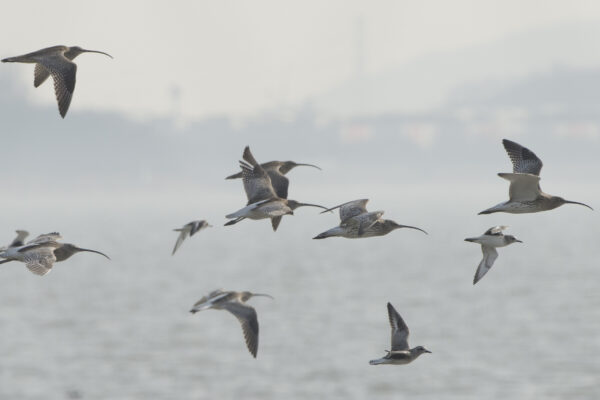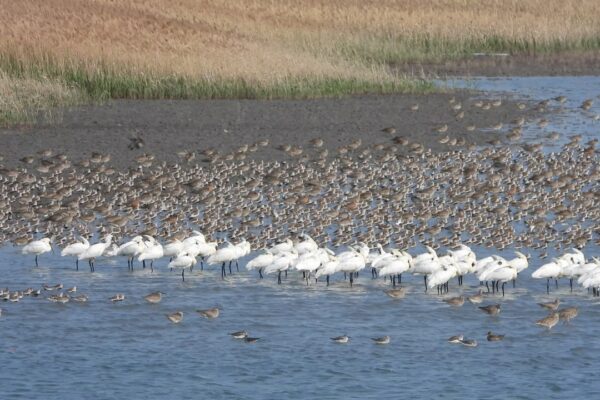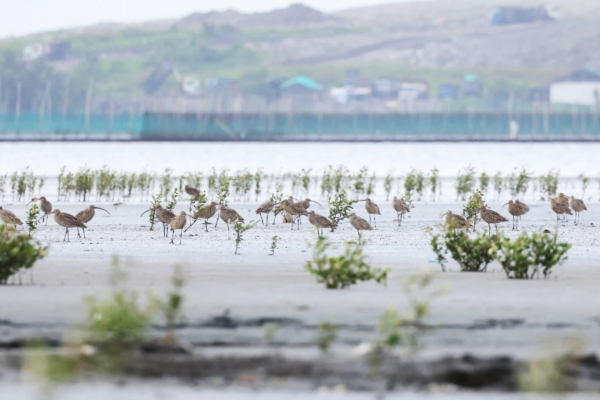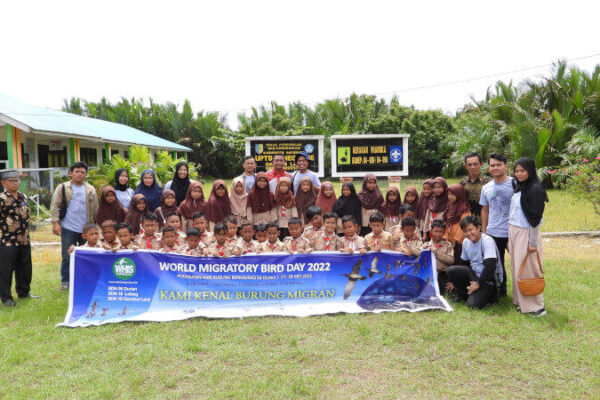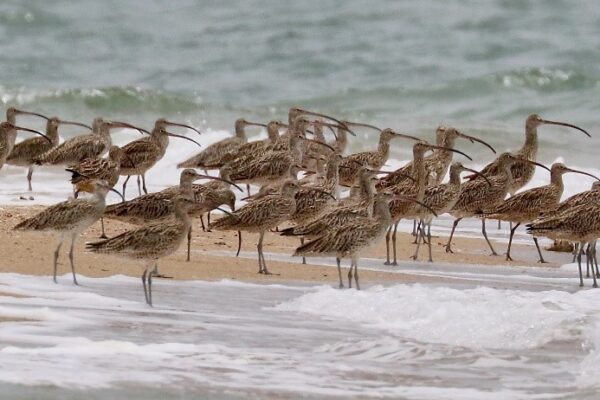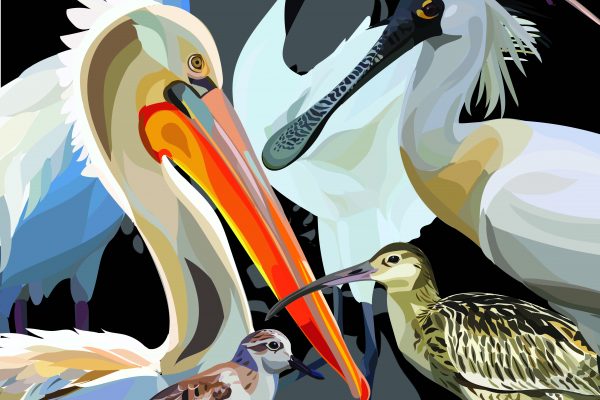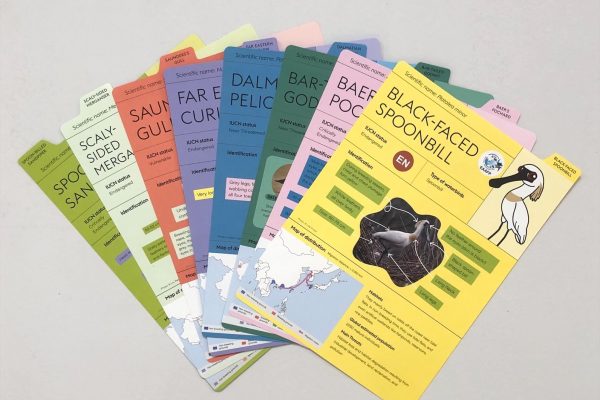-
Funding Boost for Flyway Activities: Australian Government’s Support and Priorities
©Eugene Cheah The Australian Government has extended its support for several key activities of CMS-EAAFP. Four…
Continue reading -
Republic of Korea: Yeongjong Tidal Flat Bird Monitoring Reveals High Conservation Value
The comprehensive bird monitoring conducted at Yeongjong Tidal Flat in Incheon, Ro Korea, in 2022, led by a team of dedicated citizen scientists and local NGOs (Green Korea Incheon and Waterbird Network Korea) has yielded scientific insights into the ecological significance of this habitat. The survey findings provide substantial evidence supporting the potential listing of Yeongjong Tidal Flat as a World Natural Heritage site proved to be a globally significant habitat for endangered bird species. © Yeongjong Tidal Flat Monitoring Team Over 16 surveys spanning April to November 2022, the team investigated the population dynamics and migratory patterns of seven endangered bird species. The survey locations included Yaedanpo Port, Midan City, Songsan Reservoir, Hongdae Salt Field, and Incheon Bridge. © Yeongjong Tidal Flat Monitoring Team The observations revealed a total count of 14,518 individuals across the seven targeted species. The birds exhibited dynamic site selection, utilizing survey points as strategic feeding and resting sites aligned with tidal patterns. Notably, during high tides, the Songsan Reservoir and dormant Hongdae Salt Field emerged as significant resting sites. © Yeongjong Tidal Flat Monitoring Team Of particular importance is the presence of the Far Eastern Curlew, a migratory bird covering vast distances between Siberia and Southeast Australasia. Yeongjong Tidal Flat was found to host approximately 18% of the estimated global population (35,000 individuals) of this species, according to Wetland International. Far Eastern Curlews (left) and Black-faced Spoonbills (right) © Yeongjong Tidal Flat Monitoring Team Furthermore, Yeongjong Tidal Flat supports approximately 10% of the maximum breeding population of the Black-faced Spoonbill, which over 80% of its global population breeds in Incheon. Eurasian Oystercatcher (left) and its eggs (right) © Yeongjong Tidal Flat Monitoring Team The Eurasian Oystercatchers, predominantly nesting near the First Dredge Dumping Grounds, also exhibited substantial breeding activity, though some nests faced challenges with egg disappearance or damage. The presence of campers utilizing interior spaces of the First Dredge Dumping Grounds during the breeding season poses an additional threat to the successful reproduction of Eurasian Oystercatchers. © Yeongjong Tidal Flat Monitoring Team Situated within the East Asian-Australasian Flyway (EAAF), Yeongjong Tidal Flat serves as a vital resting and feeding ground for internationally protected bird species. Consequently, urgent conservation efforts are necessary to secure its inclusion on the UNESCO World Heritage list during the 48th session of the committee in 2026. The designation of Yeongjong Tidal Flat as a protected wetland area and recognition as a World Natural Heritage site would ensure the preservation of its ecological significance. © Yeongjong Tidal Flat Monitoring Team In addition to birds recorded, the team also found the Milky Fiddler Crab at the site which is a Nationally Endangered Species (Category II). Milky Fiddler Crab © Ju Hyeok Lee/EAAFP Secretariat The recent inauguration ceremony for the second batch of the Yeongjong Tidal Flat Bird Monitoring Team signifies ongoing efforts in monitoring avian populations within this unique ecosystem. A conference focused on Yeongjong Tidal Flat conservation, based on the survey results, is planned for the end of the year, facilitating collaboration among stakeholders. © Yeongjong Tidal Flat Monitoring Team The results of the Yeongjong Tidal Flat bird monitoring project provide scientific evidence of its high conservation value. Listing Yeongjong Tidal Flat as a World Natural Heritage site would ensure appropriate protection and conservation measures for the endangered bird species that rely on this habitat. The dedication of the monitoring team, citizen scientists, and stakeholders involved in preserving Yeongjong Tidal Flat will play a pivotal role in securing a sustainable future for this important ecosystem and its avian inhabitants. Read the report (in Korean) here. Article prepared by Yeongjong Tidal Flat Monitoring Team.
Continue reading -
Summary of interim results of Shorebird Hunting Impact Assessment Project: northern part of EAAF in North-East of Russia (2019-2021)
EAAFP Small Grant Fund project by Konstantin B. Klokov, Saint-Petersburg State University & Peter the Great Museum of Anthropology and Ethnography (Kunstkamera) RAS; Aleksandr I.Matsyna, Working Group on Shorebirds of Northern Eurasia The first approach to assessment of hunting pressure on shorebirds in selected areas of the Kamchatka Peninsula, with special focus on the Far-Eastern Curlew. Moscow – Petropavlovsk-Kamchatsky, 2019. By Konstantin B. Klokov, Yuri N. Gerasimov, Kamchatka Branch of Pacific Institute of Geography FED RAS/BirdsRussia Kamchatka Branch, Evgeny Syroechkovskiy Ministry of Natural Resources and Environment of Russian Federation/Birds Russia, Russia, with contribution from: Sergey Kharitonov, Russian Bird Ringing Centre IPEE RAN Rus Acad Sci., Anton Ivanov, Working Group on Shorebirds on Northern Eurasia, Dmitriy Dorofeev, All-Russian Research Institute for Nature Conservation. The assessment of hunting pressure on shorebirds in Sakhalin Island, with special focus on the Far-Eastern Moscow - Nizhniy Novgorod – Yuzhno-Sakhalinsk, 2020. By Aleksandr I.Matsyna, Working Group on Shorebirds of Northern Eurasia, Matsyna Ekaterina L., Working Group on Shorebirds of Northern Eurasia, Konstantin B. Klokov, Evgeny E. Syroechkovskiy, with contribution from: Sergey Kharitonov, Zoia V.Reviakina, Working Group on Shorebirds of Northern Eurasia, Vladimir B. Zykov, Working Group on Shorebirds of Northern Eurasia. Evaluation of hunting pressure of shorebirds in the Russian Far East with special attention to Numenius (Curlews, Whimbrels) and other threatened species - Stage III: surveys in Khabarovskiy Krai and Amur oblast’. Moscow - Nizhniy Novgorod - Khabarovsk – Blagoveshchensk, 2021. By Aleksandr Matsyna, Vladimir Pronkevich, Institute of Water and Ecology Problems, Ekaterina L. Matsyna, Anton A. Sasin, Blagoveshchensk, Konstantin Klokov, Evgeny E. Syroechkovskiy, with contribution from Sergey Kharitonov. INTRODUCTION Conservation of Arctic migratory bird is based on holistic approach, which treated together all species' habitats within its annual life cycle. Arctic-breeding migratory birds are a significant component of both Arctic culture and ecosystem health. Many of them require special attention of researchers as they are among the rare and endangered species or the game resources. The protection of Arctic migratory birds, as well as the issues of sustainable use of their resources (concerning game species) are complicated because Arctic-breeding birds use different flyways to move from Arctic breeding grounds to overwintering or stopover sites at lower latitudes. Migration routes from breeding areas in the eastern part of Russian Arctic to overwintering and stopover sites follow mainly the western coast of the Pacific Ocean and cross 22 Asian countries. The sum of these routes is defined as the East Asian-Australasian Flyway (EAAF). The EAAF is the most species-rich of the world’s nine major flyways. In addition, the EAAF has the highest proportion of declining at an unprecedented rate waterbird populations, especially shorebirds. Of the 63 populations of 52 migratory species of shorebirds migrating this way, 20 populations of 17 species may become extinct or approach extinction in the near future if no measures are taken [1, 2, 3]. Over the past 30 years, this problem has attracted the attention of many ornithologists and conservationists. The main reason for the decline in EAAF shorebirds populations is the reduction of the main habitats: coastal and inland wetlands [4, 5]. Hunting is also perceived as a medium-or high-level threat, but it is difficult to assess its scale due to poor knowledge of the issue [6, 7]. The Arctic Migratory Bird Initiative (AMBI) was started by CAFF in 2015, and aims to improve the conservation status and secure the long-term sustainability of declining of Arctic-breeding migratory birds through flyway-level cooperation with Arctic and non-Arctic countries and partners. AMBI is working across four major flyways to engage global partners on the issue of bird and habitat conservation, including the mitigation of harmful anthropogenic actions and hunting. AMBI Work Plan objective 3 states to prevent illegal hunting and regulate unsustainable legal harvest of Arctic migratory birds along the EAAF, with a focus on Spoon-billed Sandpiper (SBS), Lesser White-fronted Goose, Bar-tailed Godwit, and other priority species. Action 3.1 initiates surveys of hunting pressure on Arctic-breeding shorebirds in stopover areas in the North-East of Russia, including Chukotka, Kamchatka, Sakhalin and mainland coasts of Sea of Okhotsk [8]. Implementation of these activities was started in 2019 by BirdsRussia in cooperation with Working Group on Waders on Northern Eurasia. It is the first project focused on the assessment of hunting pressure on Arctic shorebirds in Russia. The main aim is to reveal the territories of the largest hunting bag of shorebirds and specify the dates (season) of hunting there first of all for priority East Asia-Australasia Flyway Partnership species of shorebirds (waders): Curlew Sandpiper, Red Knot (Calidris canutus), Great Knot (Calidris tenuirostris), Far Eastern Curlew (Numenius madagascariensis), Black-tailed Godwit and Spoon-billed Sandpiper (Eurynorhynchus pygmeus). Special attention is paid to Whimbrel (Numenius phaeopus), which is the most popular shorebird target species for legal hunting in the Russian Far East as well as to the most important endangered species: Far Eastern Curlew, Godwit, SBS, etc 1.PROJECT GOAL AND OBJECTIVES The main goal of the project is to assess shorebird hunting pressure in the northern part of the EAAF in the north-east of Russia. The project is focused on shorebird species prioritised by the EAAFP. Special attention was focused on Far Eastern Curlew, Whimbrel and SBS. Whimbrel is a popular species for legal hunting in the Far East of Russia and hunting has a significant impact on the number of this species. Far Eastern Curlew is included in the list of globally threatened species (IUCN Red List) and is critically endangered in Australia. In Russia it is a protected species, included in the Red Data book. Nevertheless, hunters quite frequently harvest Far Eastern Curlew together with Whimbrel due to misidentification and often do it on purpose as for many hunters it is the most wanted game among all the shorebird species because of its large size. Both species are understudied and when the opportunity presents itself we fill the knowledge gaps about them, their conservation and use. SBS is a critically endangered species, one of the rarest shorebirds in Russia and in the world. An important goal of the project is to identify modern and historic population trends of different species and ecological groups of shorebirds under hunting pressure (both legal and illegal bird harvest) as well as other factors. Thus, the following objectives had to be attained: Identify main shorebird staging sites during migration where they are subject to intensive hunting Compare the timing of hunting seasons with the timing of migration and stop- overs of different shorebird species, identify the most vulnerable Estimate the number of shorebird hunters in different areas of the Russian Far East, including hunters on large-sized, medium-sized and small-sized Inspect model settlements (villages and small towns), including interviews, anonymous questionnaires and direct observation of hunting processes within the project time- Assess the feasibility and attempt to organize online anonymous Give an estimate of an average number of shorebirds harvested by one hunter in different regions of the Russian Far Calculate an estimate of shorebird harvest in different regions of the Russian Far using expert assessment and, where possible, extrapolation, in particular to give an approximate estimate for large and small-sized shorebird harvest and for the most important species, if A separate task is to develop and refine the research methods of assessing the hunting pressure on shorebirds in the Far This is a pioneer line of research started practically from scratch. Methods are improved every year. 2.METHODOLOGY The methodology is based on the waterfowl hunting estimation experience in the eastern part of Russian Arctic. It was developed by E.E. Syroechkovsky and K.B. Klokov and used in 1999–2006 to make an estimation of bird harvest in 22 villages of Chukotka and northern Yakutia located near the sea coast [9]. We slightly changed this method in connection to the fact that, unlike waterfowl, shorebirds are not the main object of hunting. According to our methodology the survey of each village includes two steps. First, an in-depth interview with 2–3 experts takes place to identify at a qualitative level the general picture of the way how shorebird hunting occurs at this place and how important it is for local hunters. As a result of the interview we learned about the bigger picture of shorebird hunting in the village. The second step was the survey using anonymous questionnaires, which were filled by hunters themselves. The questionnaire was made as short as possible because each extra question increases the possibility that the hunter would think the questionnaire is too complicated and would not want to waste time completing it. The main part of hunters does not distinguish species of shorebirds. Therefore, in anonymous questionnaires, we mostly do not use names of shorebird species, but ask hunters to divide the harvested shorebirds into the following groups: Whimbrel, which is very popular and well known to Russian Far East hunters, other big-sized shorebirds except Whimbrel, medium-sized shorebirds, small-sized In addition, we asked to list the species of harvested shorebirds, if the hunter knows them, but only a few of respondents did this. Sampling. Since it was not possible to create a random sample, we used two methods: Asked hunters to fill out a questionnaire at the time when they visited the office of the hunting society in order to return a seasonal hunting permit. This method was mainly used the help of employees of the hunting societies. However, it was not possible to use it in all The Snowball Method, when each hunter, filling out a questionnaire, gave the contact details of one or more other hunters. This method gives good results in small Apart from the survey of hunters in settlements, we conducted a direct observation of the hunting process with visual inspection of the hunters' harvest at the model plots. This allowed to identify species and species ratio of shorebirds and other birds harvested there. The advantage of the direct observations of hunters at the model plots was the possibility to observe the hunting process, conduct a significantly higher number of informal interviews with hunters and visually inspect their harvest, which allowed to identify species of harvested shorebirds, which hunters themselves did not know. 3.SURVEYED REGIONS Survey on the impact of various aspects of hunting on the population and numbers of shorebirds in the Russian Far East has been carried out for three years. During this period four regions have been surveyed (fig. 1). Figure 1: Regions of the Russian Far East surveyed in 2019-2021 as part of the Shorebird Hunting Impact Assessment Project: 4 - Amur Oblast, 5 - Khabarovsk Krai, 7 - Sakhalin Oblast, 10 - Kamchatka Krai Regions proposed for survey in the nearest years: 8 - Magadan Oblast, 6 - Primorskiy Krai, 1 - Republic of Buryatia and 2 - Zabaykalskiy Krai; Regions for prospective studies: 3 - Republic of Sakha (Yakutia), 9 - Chukotka Autonomous Okrug. Kamchatka. Here, in 2019, the methodology of material collection was tested and perfected. It was based on anonymous questionnaires. The questionnaires were distributed through the hunting organization service. A total of 400 questionnaires were collected. For the first time, the number of harvested shorebirds of two size groups, large/medium and small species, was estimated for this region (Table 1). Table 1. Estimation of number of harvested shorebirds in Kamchatka in 2019 Sakhalin Oblast, survey 2020. Sakhalin Island is one of the most populated and developed regions of the Russian Far East and a very important migration area for many shorebird species. There are many hunters here and many places with high concentrations of shorebirds. On Sakhalin we have conducted many interviews and informal discussions with hunters. This allowed us to determine the level of harvesting of different shorebird species more accurately (Table 2). Total amount of shorebird harvested on Sakhalin was even higher than on Kamchatka! Particularly alarming was an unexpectedly high level of harvesting of Far Eastern Curlew. While in Kamchatka hunters shot it mainly due to ignorance and confusion with Whimbrel, on Sakhalin this species is a prestigious trophy for many hunters. Table 2. Expert assessment of yearly harvest of shorebirds in the Sakhalin oblast based on the survey results * - number of harvested birds varies depending on the Whimbrel population number fluctuation from year to year ** - harvest is underestimated as survey data does not fully reflect the shorebird harvest in several districts of Sakhalin island Khabarovsk Krai, survey 2021. Hunting here has a large impact on shorebirds in the areas adjacent to the Sea of Okhotsk. Species such as Great Knot, Red Knot, Bar-tailed Godwit, and others are regularly and in considerable numbers shot there. We also recorded incidental harvesting of the SBS in Okhotsk. Hunters do not distinguish between species of shorebirds and usually shoot in flocks. The Far Eastern Curlew is less harvested here than on Sakhalin. Hunters shot it mainly in central part of Khabarovsk Krai and in the valley of Amur River (Table 3). Table 3. Estimation of number of yearly harvested shorebirds in Khabarovsk Krai Amur Oblast, survey 2021. Shorebird hunting is less developed here, as there are no large migratory concentrations of shorebirds. Nevertheless, the Far Eastern Curlew is threatened here as well. This species is most often hunted either in spring, during duck hunting, either by poachers. Table 4. Estimation of number of yearly harvested shorebirds in Amur Oblast Our project enabled us to obtain, for the first time, information on the scale of shorebird hunting in the Russian Far East. This is their great value. For a number of areas, such as the coast of the Sea of Okhotsk in Khabarovsk Krai and the coast of Western Sakhalin, additional research is needed as our level of knowledge about these areas remains insufficient. We envisage, if circumstances permit, to continue surveys in the remaining regions of the Far East: the Magadan Oblast (survey has been planned for autumn 2022), Primorskiy Krai and also Yakutia. 1.SPECIES AND GROUP OF SPECIES Let us consider briefly the results of the project in Kamchatka, Sakhalin, Khabarovsk Territory and Amur Oblast for selected shorebird species and groups of species. Far Eastern Curlew As the interviews show, hunters while hunting the Whimbrel often do shoot large shorebirds, including Far Eastern Curlews, Bar-tailed and Black-tailed Godwits. Some hunters do not know the right name of the species, though many of them are aware of them. Here we should distinguish between “proper poaching”, when hunters do it on purpose – they shoot all large shorebirds that have come close to them (the case common for some districts in Sakhalin Island), and "accidental poaching", when hunters shoot Far Eastern Curlews by mistake. The main reason for the error is the fact that young Curlews have a shorter bill than adult ones (similar to the Whimbrel’s bill), and hunters confuse these two species. The total number of harvested Far Eastern Curlew in all surveyed regions of the Far East, according to our estimates, may amount to more than 2 000 birds per year (table 5). In Kamchatka and partly on Sakhalin, hunters shoot it mostly occasionally when hunting Whimbrel during their southward migration. In Khabarovsk Krai and Amur Oblast, it is harvested mainly in spring, in breeding grounds (fig. 2). Table 5. Estimation of number of yearly harvested Far Eastern Curlew (Numenius madagascariensis) in different region of Russian Far East Figure 2. Areas of the highest probability of shooting on Far Eastern Curlew during the breeding and migration periods (highlighted by shading) Whimbrel As our calculations showed, the total number of Whimbrels shot in Kamchatka is about 37,000 per year. This is a very large number compared to published estimates [1, 2], where the total EAAF population of the Whimbrel is supposed to be about 55,000 birds. Considering that Whimbrels besides Kamchatka are also harvested in other regions, our results suggest that the flyway population estimate of 55,000 birds for Whimbrel is significantly lower than in reality. Published observations of Whimbrel concentrations in the several staging places [10, 11, 12, 13] and our long-term observations [14, 15] in Kamchatka also confirm this. We believe that hunters of Kamchatka and Sakhakin are making the greatest impact on the Whimbrel population on the flyway. In addition, our work has confirmed the disproportionate hunting pressure on the northern population of Whimbrel migrating via Sakhalin. In contrast to Kamchatka, where numbers of the species remain stable, significant fluctuations in abundance have been observed on Sakhalin. This indicates a perennial depression of the species in the region as a result of disproportionate hunting pressure. This is particularly dangerous when combined with the major transformation of these birds' natural habitats by oil and gas developments in northern Sakhalin. But need to survey all other parts of the flyway to verify these conclusions. Small and medium-sized shorebirds Small- and medium-sized shorebirds are not actually object of purposeful hunting. Many of them are not game species in Russia, which are not supposed to be shot. According to informal interviews, hunters shoot them not so often. Small and medium-sized shorebirds are mainly harvested: by children and teenagers, who do not have an official right to hunt but whose parents want to train them as hunters; in the absence of other game, in order not to return home empty-handed; by some gourmet hunters who love cooking and eating small shorebird soup considered a Reporting on the number of harvested small shorebirds in the anonymous questionnaires, hunters never identify species. As the interviews showed, hunters save cartridges and usually harvest small and medium-sized shorebirds by shooting dense flocks, often consisting of several species, often including rare ones. Such hunting results in a big number of wounded birds that die later and a significant number of killed birds that remain unrecovered. The total mortality of birds is likely 2-3 times higher than the number of birds used by hunters. So, the number of shot small shorebirds may be assessed as nearly two- fold as compared with the data from the questionnaires. Thus, in Kamchatka, according to the anonymous questionnaires in 2019, 14.3 % of hunters shot small-sized shorebirds. The average bag in all Kamchatka was 2.2 birds a year for one hunter. The total number of harvested birds calculated by extrapolation was more than 6000. More than half of the birds were harvested in western districts (Sobolevsky and Tigil’sky districts), where the average hunters bag per year is 10 small shorebirds. In the other regions it was less than 2 birds per year. In Sakhalin small shorebirds have a special place in the hunting practice. They are regularly harvested, either incidentally, as a rule when there is no other game, either intentionally. There are firmly fixed collective terms for this groups of birds – "galushki" or "pelmeni" in the local lingo. They are traditionally used for cooking shurpa, a thick broth with fowl and vegetables. As a rule, there is at least one enthusiast in each group of hunters, who can always harvest and cook this birds. During our survey different examples of easy and fruitful hunting were given: "60 birds with one cartridge", "a basin with two cartridges", "a dozen with one shot" and others. Even with the adjustment for a known tendency to exaggerate the result, this information is unfortunately proved by our observations. For example, on August 30 2020, 12 Dunlins were harvested with one shot by a hunter who was barely 10 years old. In September at the Odoptu bay (Northern Sakhalin) we observed two hunters who fired 5 shots on dense flocks of small shorebirds in 15 minutes and left, collecting a whole bag of game. Inspecting this territory half an hour later, we found 6 other shot Dunlins, among which were wounded birds hiding in the grass. Incidental harvest of small and medium-sized shorebirds as a rule is not a memorable experience for hunters and that is why many of them give a negative answer when the question about the harvest of these birds is first asked. Therefore, remotely completed questionnaires often provide underestimated data. But during a conversation, when they are asked clarifying questions, almost all the hunters remember doing it incidentally, in passing, and only cases of a massive harvest are imprinted in memory with figures of speech, such as "half a bucket in one go". In a number of cases we were informed that these birds may not be used for food but are thrown away if hunters take more desirable game. Spoon-billed Sandpiper Spoon-billed Sandpiper currently remains one of the most endangered bird species in the world. It has a narrow nesting range in the coastal tundras of the Chukotka peninsula. IUCN international conservation status of this species is "Critically Endangered". Sakhalin plays an important role for migratory stopovers of this species. SBS was registered here by many researchers during spring and autumn migration. Unfortunately, main SBS sighting sites in Sakhalin fully coincide with the sites of active shorebird hunting. To harvest shorebirds, hunters most often shoot dense flying flocks consisting of several species, in which SBSs usually move as well. Thus, they can become victim of any such shot. Clearly, taking into account low population of SBS in total, we are far from knowing all its traditional staging sites. It is a cause for concern that during autumn migration coinciding with autumn hunting season, SBS's sightings on the shores of Sakhalin are most dispersive and the birds could potentially end up in any place where they will be shot. In our 2020 research we did not have an opportunity to look further into this topic but now we know of many districts where there is hunting pressure in the known SBS staging sites. Monitoring and special research should be conducted in several districts of Sakhalin, important for the declining population of SBS. Seasonal protection should be introduced in a number of such sites so that there is no hunting there. We know about the shot of SBS in all of the study areas along the Sea of Okhotsk - Kamchatka, Sakhalin, and Khabarovsk (fig. 3). All known cases were incidental. The birds were killed in flocks of small shorebirds. This hunt is most common not only in northern Sakhalin, but also in several districts of Khabarovsk Krai, namely Nikolayevsky, Tuguro-Chumikansky, and Okhotsk districts. The probability of shooting of SBS in the northern part of western Kamchatka coast is supported by the fact that signal transmission from three of the nine birds with radio transmitters stopped sending signal from this area [10]. The only way to influence the local population in all these areas is to carry out long-term work to educate hunters, convincing them not to shoot indiscriminately at flocks of birds. Our project has been successful in doing this, but it needs to be continued on a much larger scale. Figure 3. Areas of the highest probability of shooting on SBS during seasonal migrations (highlighted by red points) 5.CONCLUSIONS AND RECOMMENDATIONS Arctic breeding migratory birds are in significant declines in several regions, and due to the flyway- level movement of migratory birds, a large flyway-level conservation approach is needed to improve their population status. Our study of Arctic-nesting shorebirds hunting is the first significant research in this direction. It allowed to get the first idea of shorebirds hunting in Kamchatka, Sakhalin, Khabarovsk and Amur areas. To obtain a complete picture along the northern end of EAAF, it is necessary to conduct similar studies in all other regions of the Russian Far East and Russian Arctic. As well, hunting assessment and monitoring in the four regions already surveyed should be continued in order to be able to monitor the hunting process and to get more detailed data. The results of our survey clearly showed that hunting of shorebirds in the North-East of Russia (most northern part of EAAF) may negatively impact Arctic shorebird populations especially threatened species. Hunting of protected shorebirds is often the reason of low level of awareness of hunters and lack ability to distinguish between shorebird species. Awareness raising and education must be improved. Hunting for small-sized shorebirds in North-East of Russia has declined significantly over the past 40 years, however it still remains an additional threat to the conservation of the rare protected species, including SBS. Although our study filled a significant gap, the available data on shorebirds hunting in the Russian North-East is still completely insufficient to propose and justify an effective Arctic shorebird conservation program. The methodology used by us gave acceptable results. It can be used in other regions of the Russian Far East and Arctic. However, for a quantitative assessment of the harvesting of rare species it should be supplemented with other methods. Hunting control in the all North-East of Russia, is weak. For shorebird conservation special education activities are much needed not only for hunters but as well for wildlife officers. Since hunters often shoot protected shorebirds because of their inability to identify species and lack of knowledge on the protection status. As well, hunting inspectors cannot control this process because they also can’t identify many species of birds. These activities can be conducted together with hunter societies and regional hunting agency. As we learned during our research, hunting societies are open to such activities. But they have limited resources. Significant part of hunters are really interesting to know species which they are harvesting. But there is no place where they can learn. The publication of a field guide of shorebirds of the Russian Far East is really very important for improving the level of knowledge of hunters and hunting officers. Effective conservation of shorebirds requires significantly more data on hunting bag. First of all, we need full information on all regions of Russian Far East in order to get a complete picture along the entire flyway. Secondly, it is necessary to move from a single survey to monitoring of the harvest year by year. 6.PERSPECTIVES FOR FURTHER RESEARCH Our research showed that hunting in the Far East of Russia is probably a more significant factor in the population decline of several shorebird species along the EAAF than it was previously believed. That is why international collaboration to assess hunting pressure should be continued, including activities under EAAFP, partnership with AMBI-CAFF and interactions with bilateral conventions. Based on the full inventory of knowledge about hunting in all the regions of the Russian Far East, it is necessary to conduct further research, organise monitoring and implement conservation programs. We need consider perspectives for further research, first of all, in four new regions. Magadan Oblast. This is an active waterfowl and shorebird hunting area. We expect to conduct detailed surveys here in autumn 2022, and obtain information which will help better understand the scale of harvesting of small-sized shorebirds in this area and the probability of SBS loses, as well as the situation with the catastrophic decline of the Whimbrel on Sakhalin. Primorsky Krai. The south of Primorskiy Krai, including the Lowland around the Khanka lake, is an important region for shorebirds. During migrations, many rare species stop here, including Far Eastern Curlew, Spotted Greenshank (Tringa guttifer), SBS and others. Assessment of the impact of hunting on these species is very important. These two regions should be surveyed first. Figure 4 shows the main flyways of Dunlin. The same flyways are followed by most of the other shorebirds (especially small ones) in the Sea of Okhotsk area. On this map (fig. 4) we can see that Magadan Oblast and Primorsky Krais are located along these flyways. This is also confirmed by the map presented in our report for 2019 (fig. 5), based on data from the Russian Ringing Centre and other sources. The map shows human settlements and main areas of shorebirds hunting located only on the sea coast. Figure 4. Main northward (A) and southward (B) flyways of Dunlins in the Sea of Okhotsk region [11]In the future, it would be advisable to extend the observation area and survey three inland regions as well: Zabaikalskiy Krai and Republic of Buryatia (Transbaikalia). This is an important migratory area with rather large and long stopovers of shorebirds on inland water bodies. There is no evaluation of hunting pressure on shorebirds in this regions. Yakutia. Sakha (Yakutia) Republic is the largest administrative region of Russia. Both amateur and commercial hunting is developed here. According to data of Russian Ringer Center there are many shorebird rings recovery from this region. Despite its huge surface there are road and river transport network, which will allow to organize visits to o necessary districts with shorebird hunting activities. Besides new regions, the continuation of research in several districts on the coast of Sea of Okhotsk in the Khabarovsk Krai as well as in several districts on Sakhalin Island (Ohinsky and Aleksandrovsk-Sakhalinsky districts are highly desirable. The coast of the Sea of Okhotsk is one of the least ornithologically investigated areas of the mainland coast, where important shorebird concentration sites during autumn migration are concentrated and hunting pressure is high. Figure 5. Human settlements located at the seacoast of the Russian Far East and main areas of shorebirds hunting identified from data of rings recoveries of Russian ringer centre, published sources and unpublished knowledge of Russian ornithologists South-western coast of Sakhalin is important area for the nesting and migration of shorebirds but very poorly studied. The most important of its bays (Tyk, Viakhtu, the Lakh river estuary) are lacking data on the number and species composition on stopovers. This is the place where SBS stops for a long time (Qing, Syroechkovskiy et al, 2020) and where the largest of known habitats of Nordmann's Greenshank remain. All of these regions, with the exception of Zabaikalskiy Krai and Republic of Buryatia, are located within the breeding range of the Far Eastern Curlew. Continued research will provide new information on the current abundance of the species, its dynamics and threats. The coast of the Sea of Okhotsk in Magadan Oblast and Primorsky Krai is also important for migrations of other rare species of shorebirds in the region - SBS, Spotted Greenshank, Little Curlew (Numenius minutus). The continuation of this project is currently the only opportunity to obtain valuable information for the development of the conservation strategy for these species. Another important argument for continuing the initiated project is the active involvement of specialists from various regions of the Far East. Their attention to the question of the hunting pressure on shorebirds opens a new perspective on the role of anthropogenic pressure in the condition of rare and as yet common species of birds. And it also helps to lobby the interests of nature conservation through a constructive dialogue with the authorities. Acknowledgments The project was supported by Karl Kaus Fondation, The East Asian – Australasian Flyway Partnership, Australian Government, the Australian State Department of Agriculture, Water and the Environment, Manfred-Hermsen-Stiftung and UNEP/CMS. Russian Bird Ringing Centre provided data on shorebirds ring recoveries. The Forestry and Wildlife Protection Agencies of Kamchatskiy and Khabarovskiy Krais and Amur Oblast, Ministry of Forestry and Hunting of Sakhalin oblast provided logistics help and data on the number of hunters and hunting permits issued. We acknowledge employees of these agencies, as well as the experts and consultants who provided valuable information on the population, distribution and harvesting of shorebirds in Russian Far East. References Bamford M et al 2008 Migratory shorebirds of the East Asian-Australasian Flyway: Population estimates and internationally important sites (Canberra: Wetlands International – Oceania) Conklin J R et 2014 Prioritizing migratory shorebirds for conservation action on the East Asian-Australasian Flyway (Hong Kong) Pearce-Higgins J W et al 2017 A global threats overview for Numeniini populations: synthesizing expert knowledge for a group of declining migratory birds Bird Conservation International 27 (1) p 6–34 Melville D S et al 2016 Shorebirds along the Yellow Sea coast of China face an uncertain future: A review of threats Emu 11 p 100–110 Studds C E et al 2017 Rapid population decline in migratory shorebirds relying on Yellow Sea tidal mudflats as stopover sites Nature Communications 8 14895 Naves L C et al 2019 Shorebird subsistence harvest and indigenous knowledge in Alaska: Informing harvest management and engaging users in shorebird conservation The Ornotholodgical applications 121 p 1–19 Cajiao E J W et al 2020 Extent and potential impact of hunting on migratory shorebirds in the Asia-Pacific Biological Conservation 246 p 1–12 CAFF Congress 2018 MB5: Worldwide partnerships to conserve migratory birds: The Arctic Migratory Bird Initiative Available from: https://www.caff.is/arctic-migratory-birds- initiative-ambi [Accessed 8th October 2021] Syroetchkovskiy E E and Klokov K B 2010 Using questionnaire method to study the impact of hunting on waterfowl in the Russian Arctic Cazarka 13 p 76-103 Gerasimov Yu N 1998 Spring migration of waders in the mouth of Bolshaya River (West Kamchatka) Ornithology 28 p 222 Huettmann F and Gerasimov Yu 2002 Using Sampling to obtain density estimates for Whimbrels (Numenius phaeopus) and other birds in the coastal tundra of the Moroshechnaya River Spit, Sea of Okhotsk, during fall migration Avian Ecology and Behavior 8 p 49–69 Schuckard R F et al 2006 Shorebird and Gull Census at Moroshechnaya Estuary, Kamchatka, Far East Russia, During August 2004 Stilt 50 p 34-46 Gerasimov Yu N et al 2019 Some results of studying the summer-autumn migration of waders on the Bolshaya Vorovskaya River Lagoon, Western Kamchatka Topical issues of studying waders of Northern Eurasia. Materials of the XI International conference (Minsk) p 15-19 Gerasimov Yu N and Gerasimov N N 2002 Whimbrel Numenius phaeopus on Kamchatka, Russia Stilt 41 p 48-54 Gerasimov N N and Gerasimov Yu N 2014 Study of migration of waterfowl and shorebirds of Kamchatka Materials International scientific conference “Areas, migrations and other movements wild animals” (Vladivostok, Russia) p 52-61 Qing Ch et al 2020 Post-breeding migration of adult Spoon-billed Sandpiper Wader study 127 (3) p 200-209. Tiunov I.M., Yu.N. Gerasimov & A.I. Matsyna 2018. Seasonal migrations of the Dunlin Calisdis alpina in the Sea of Okhotsk region // The biology and conservation of the birds of Kamchatka 11: 25-48. (In Russian). The project was funded through the 2019-2020 EAAFP WG/TF Small Grant Fund. View the report, Click here (2019, 2020).
Continue reading -
The search for Far Eastern Curlews in the Philippines
Fig. 1. Far Eastern Curlews in Tanza, Navotas City 2022. © Irene Dy Far Eastern Curlew (Numenius madagascariensis) is a large shorebird species found in the East Asian-Australasian Flyway. It is assessed by the International Union for the Conservation of Nature (IUCN) as an Endangered species and is part of Appendix I of the Convention on Migratory Species (CMS). The species is mainly threatened by habitat loss due to conversion of mudflats for agricultural purposes, mangrove plantation directly in the mudflats, reclamation, and urbanization. They also face threats such as solid waste and water pollution, fishing bycatch, human disturbance, and climate change. The Philippines is a mega diverse country found in the Southeast Asian region. It is home to about 725 species of birds, wherein 278 species are migratory or accidental species. As an archipelagic country comprising of 7,640 islands, it has extensive coastal shorelines and bodies of water that are ideal for shorebirds including curlews. Figure 2. Philippine Map showing major areas surveyed In selected dates from October to December 2022, eight major areas in the Philippines were visited to conduct census of Far Eastern Curlew (Fig. 2). In mainland Luzon, sites surveyed were Pamarawan in Bulacan province, Tanza in National Capital Region, and localities in La Union province. In Bicol Region, Masbate localities were surveyed. In the Southwestern part of Greater Luzon, Mindoro localities were surveyed. And in the West Visayas Region, Cebu, Negros, and Iloilo were the areas surveyed. All surveys were led by Irene Dy, a professional Filipino bird guide and bird photographer. She has conducted multiple birding expeditions, both personal and professional guidance as well as volunteered for local and national environmental NGOs and other organizations for awareness raising and conservation of Philippine birds. The Far Eastern Curlew census started on 28 October, 2022, until 28 December, 2022 taking into account the tide levels in each of the areas surveyed. Pamarawan surveys were conducted on 28 October, 2022 and 27 November, 2022. Five sites were surveyed: Vitas Mudflat, Sandbar-Mudflat, Pulo-Pulo Mudflat, Berting’s Salt Farm, and Albert’s Salt Farm. A total of 45 species was recorded throughout the survey period with a maximum total count of 17,012 individuals. On Far Eastern Curlew, only one individual was recorded at Pulo-Pulo Mudflat. Other significant records were Nordmann’s Greenshank, Great Knot, and Chinese Egret. In Tanza, Navotas City, surveys were conducted on 31 October, 2022 and 01 November, 2022. This area had the highest number of Far Eastern Curlews recorded, with a maximum total count of 99 individuals. Far Eastern Curlew flock spread across the water edge of mudflat and the drier part near the mangrove area. Individuals were observed to be either resting, sleeping, foraging, actively vocalizing in the mudflat, duetting in pairs while in flight, or actively vocalizing flock while in flight from mudflat going to the mouth of Batasan River. Accounting all the sightings, a total of 44 species of birds were recorded and with a maximum total count of 13, 882 individuals. Other threatened species include Great Knot and Chinese Egret. In Mandaue City, Cebu, the surveys were conducted from 12-13 November, 2022. Four sites were surveyed: Fishpond site, Mudflat 1A, Mudflat 1B, and Mudflat 1C. A maximum total count of 24 Far Eastern Curlew was recorded. As an assessment, the ponds are high tide roosting sites of the species along with several other species. Site counts are totally tidal level dependent. Far Eastern Curlews tend to congregate in large numbers in the ponds inside the mangrove area during high tide. The total count of species recorded was 33 and a maximum total count of 1,050 individuals. Threatened species recorded were the Far Eastern Curlew and Chinese Egret. In Negros Island, sites within the Negros Occidental Coastal Wetlands Conservation Area (NOCWCA) were surveyed from 15-18 November, 2022. These include barangays Tibsoc and Nayon in San Enrique; Pulupandan; barangays Bocana and Andulauan in Ilog. A maximum total count of ten Far Eastern Curlew was recorded. Accounting all species, a total of 54 species was recorded with a maximum total count of 4,256 individuals. In Iloilo province, surveys were conducted on 19-20 November, 2022. Sites include Balabago and Bitoon in Jaro District as well as Hinactacan in La Paz District, all within Iloilo City. A maximum total count of 36 Far Eastern Curlews were recorded. On the other hand, a total of 54 species of birds was recorded with a maximum total count of 2,941 individuals. Within the Philippines, this site has one of the most numerous sightings of Lesser Sand Plover (Tibetan) (Charadrius mongolus atrifons) hence the record during the survey was very significant. Survey in Masbate in the Bicol Region was conducted on 23-25 November, 2022. Mangrovetum Park and Pawa Mangrove Park in Masbate City as well as Naro Island Wildlife Sanctuary were the sites surveyed. A total of 47 species of birds was recorded with a maximum total count of 954 individuals. A male individual of Far Eastern Curlew was sighted at Naro Island. Threatened species recorded include Far Eastern Curlew, Chinese Egret, and a Visayan Hornbill at Pawa Mangrove Park. In Mindoro, surveys were conducted on November 28-30, 2022. Sites include Silonay and Maidlang area in Calapan City, Oriental Mindoro as well as wetlands in the municipality of Pola, Oriental Mindoro. Presence of Far Eastern Curlew wasn’t documented though another site in Calapan City, Mahal Na Pangalan Marine Park had records of Far Eastern Curlews on October 09, 2021 (two individuals) and on November 20, 2021 (one individual). Throughout the survey, a total of 33 species was recorded with a maximum total count of 3,346 individuals. La Union was the last area surveyed on December 26-28, 2022. Sites surveyed were within the towns of Santo Tomas and Agoo. A total of eight Far Eastern Curlew was recorded throughout the survey period. Accounting all the species recorded, a total of 42 species was recorded with a maximum total of 1,267 individuals. Aside from Far Eastern Curlew, threatened species include the Java Sparrow, Chinese Egret and Philippine Duck. Figure 3. Maximum total counts of Far Eastern Curlew in each of the main areas surveyed Figure 4. Total species recorded in each of the main areas surveyed Figure 5. Maximum total count of individuals in each of the main areas surveyed Throughout the survey period, Irene Dy was also able build capacity and influence locals as well as government personnel regarding bird identification and informing biodiversity conservation. They are now aware of the different species of migratory shorebirds, their importance, and their habitats. Figure 6. Local from Bitoon, Lapaz District, Iloilo City, Iloilo Province observing shorebirds and waders including Far Eastern Curlew. Photo © Irene Dy 2022 The census received a lot of support from locals, local birders, local government units, as well as the Department of Environment and Natural Resources (DENR). A sincere gratitude to Lyndon Grondiano, a Cebu-based birder, who supported the survey in Cebu; Hon. Rose Faith Paas and the local government unit of Tibsoc in San Enrique, Negros Occidental as well as Kim Castańares of Ilog, Negros Occidental for their support and assistance in the surveys conducted in Negros; the DENR-Provincial Environment and Natural Resources Office (PENRO) of Oriental Mindoro through Amor Asi and Earl Meman, and the DENR-Community Environment and Natural Resources Office (CENRO) of Socorro, Oriental Mindoro through Jose Maria Fontanilla, Joey Albert San Diego, and Adrian Catud for their support and assistance in the surveys conducted in Mindoro; and DENR-Community Environment and Natural Resources Office (CENRO) of Mobo for their support and assistance in the surveys conducted in Masbate. Thanks to Dr. Nial Moores and Dave Bakewell for the support and advice on species identification and confirmation. Lastly, the sincerest gratitude to the government of Hwaseong City and the EAAFP Secretariat for the valuable financial support to initiate the Far Eastern Curlew census and conservation in the Philippines. Prepared by Irene Dy and Virtito Natural Jr. Citation: Dy. I & V. Natural. 2023. Far Eastern Curlew (Numenius madagascariensis) Census (2022, the Philippines). EAAFP Secretariat, Hwaseong Eco Foundation, and Hwaseong City. [link]
Continue reading -
Envisioning Roadmap of the Gochang Tidal Flat World Heritage Site management
To further develop the roadmap for advancing management of Gochang Tidal Flat after its designation as a World Heritage Site in Ro Korea, a 2-day technical workshop for…
Continue reading -
The irreplaceable habitat of Australia’s Moreton Bay to migratory watebirds, in particular to the Endangered Far Eastern Curlew
The irreplaceable habitat of Australia’s Moreton Bay to migratory watebirds, in particular to the Endangered Far Eastern Curlew Far Eastern…
Continue reading -
Seocheon City celebrated Getbol World Heritage Inscription
On 20th December 2021, Seocheon Getbol World Heritage Inscription Ceremony was held at Seocheon Arts Center to celebrate the monumental achievement of inscribing the Seocheon Tidal Flat as part…
Continue reading -
World Migratory Bird Day 2021 Poster for the East Asian-Australasian Flyway
We are celebrating World Migratory Bird Day (WMBD) twice a year, on every second Saturday of May and October. This day aims to raise awareness of migratory birds and…
Continue reading

